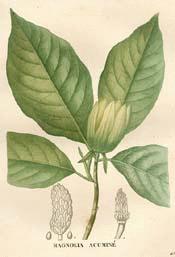
Botanical.com Home Page

|
Magnolia
(Magnolia acuminata LINN.)
Click on graphic for larger image
|
Magnolia
Botanical: Magnolia acuminata, Magnolia virginiana (LINN.)
Family: N.O. Magnoliaceae
---Synonyms---CucumberTree. Magnoliae cortex. Blue Magnolia. Swamp Sassafras. Magnolia Tripetata.
---Parts Used---Bark of stem and root.
---Habitat---North America.
---Description---The genus is named in commemoration of Pierre Magnol, a famous professor of medicine and botany of Montpellier in the early eighteenth century. All its members are handsome, with luxuriant foliage and rich flowers. The leaves of Magnolia acuminata are oval, about 6 inches long by 3 broad, and slightly hairy below, with a diameter of 6 inches, and the fruit or cone, about 3 inches long, resembles a small cucumber.
It is a large tree, reaching a height of 80 or more feet and a diameter of 3 to 5 feet, but only grows to about 16 feet in England. The wood is finely grained, taking a brilliant polish, and in its colour resembles that of the tulip or poplar, but it is less durable. It is sometimes used for large canoes and house interiors.
The bark of the young wood is curved or quilled, fissured outside, with occasional warts, and orange-brown in colour, being whitish and smooth within and the fracture short except for inner fibres. The older bark without the corky layer is brownish or whitish and fibrous. Drying and age cause the loss of its volatile, aromatic property.
---Constituents---The bark has no astringency. The tonic properties are found in varying degree in several species.
---Medicinal Action and Uses---A mild diaphoretic, tonic, and aromatic stimulant. It is used in rheumatism and malaria and is contra-indicated in inflammatory symptoms. In the Alleghany districts the cones are steeped in spirits to make a tonic tincture.
A warm infusion is laxative and sudorific, a cold one being antiperiodic and mildly tonic.
---Dosage---Fluid Extract. Frequent doses of 1/2 to 1 drachm, or the infusion in wineglassful doses.
---Other Species---
Both M. virginiana and M. tripetala were recognized as official with M. acuminata.
M. virginiana, or M. glauca, White Laurel, Beaver Tree, Swamp Sassafras, White Bay, Sweet Bay, Small or Laurel Magnolia, or Sweet Magnolia, is much used by beavers, who favour it both as food and building material. The light wood has no commercial use.
The bark and seed cones are bitter and aromatic, used as tonics, and in similar ways to M. acuminata. The leaves yield a green, volatile oil with a more pleasant odour than fennel or anise. There is probably also a bitter glucosidal principle.
M. tripetala, Umbrella Tree or Umbrella Magnolia. The fruit yields a neutral crystalline principle, Magnolin.
The bark, if chewed as a substitute for tobacco, is said to cure the habit.
[Top]
Common Name Index
A MODERN HERBAL Home Page
Bear in mind "A Modern Herbal" was written with the conventional wisdom of the early 1900's. This should be taken into account as some of the information may now be considered inaccurate, or not in accordance with modern medicine.
© Copyright Protected 1995-2025 Botanical.com
|

